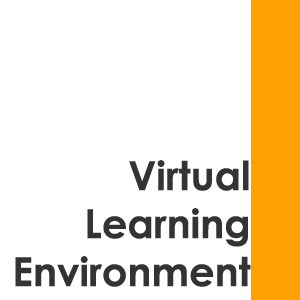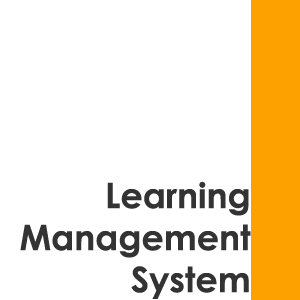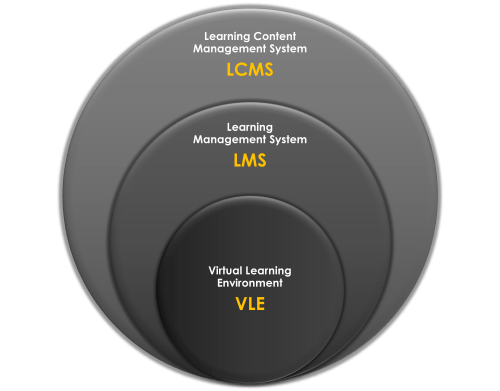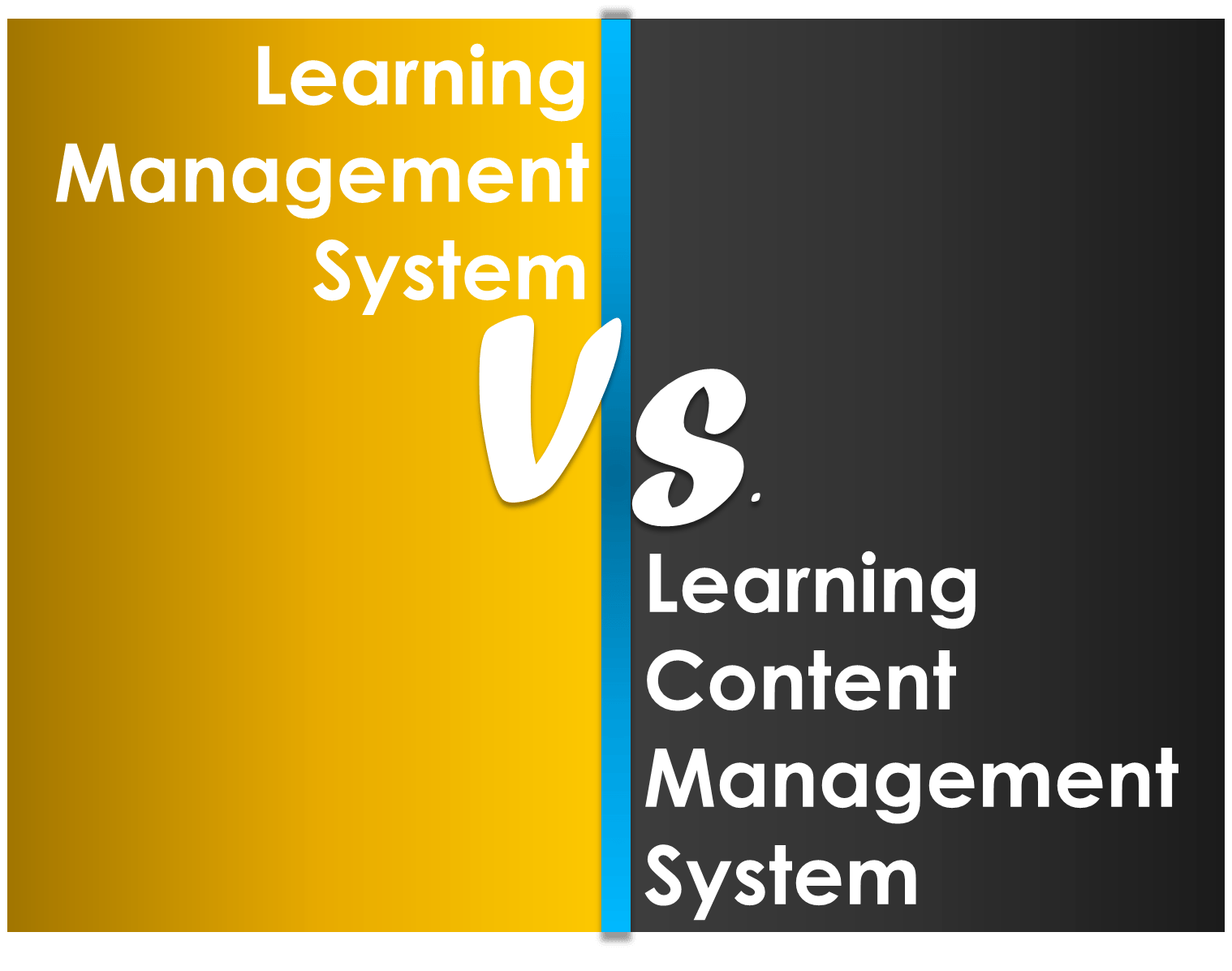In And Beyond The Classroom: 3 Categories Of eLearning Solutions
Any eLearning solution should be categorized in one of the following according to their features and components:
- Virtual Learning Environment (VLE).
- Learning Management System (LMS).
- Learning Content Management System (LCMS).
It is obvious as shown in the above figure, that the Virtual Learning Environment is the core of all eLearning solutions. On the other hand, the Learning Content Management System is the highest categorization. That is every Learning Management System is a Virtual Learning Environment and every Learning Content Management System is a Learning Management System. But the most important question every institution must ask prior to choosing the proper categorization is:
“Which solution must be chosen to work in and beyond the classroom?”
In order to answer this question, we have to know the difference between the three categories.
 Virtual Learning Environment For In And Beyond The Classroom
Virtual Learning Environment For In And Beyond The Classroom
![]() A Virtual Learning Environment (VLE) is a software system designed to support teaching and learning in an educational setting, as distinct from a Managed Learning Environment (MLE), where the focus is on management. A Virtual Learning Environment will normally work over the internet and provide a collection of tools such as those for assessment (particularly of types that can be marked automatically, such as multiple choice), communication, uploading of content, return of students’ work, peer assessment, administration of student groups, collecting and organizing student grades, questionnaires, tracking tools, etc.
A Virtual Learning Environment (VLE) is a software system designed to support teaching and learning in an educational setting, as distinct from a Managed Learning Environment (MLE), where the focus is on management. A Virtual Learning Environment will normally work over the internet and provide a collection of tools such as those for assessment (particularly of types that can be marked automatically, such as multiple choice), communication, uploading of content, return of students’ work, peer assessment, administration of student groups, collecting and organizing student grades, questionnaires, tracking tools, etc.![]()
 Learning Management System For In And Beyond The Classroom
Learning Management System For In And Beyond The Classroom
![]() A Learning Management System (LMS) is a software application for the administration, documentation, tracking, and reporting of training programs, classroom and online events, eLearning programs, and training content.
A Learning Management System (LMS) is a software application for the administration, documentation, tracking, and reporting of training programs, classroom and online events, eLearning programs, and training content.
Learning Management Systems range from systems for managing training and educational records to software for distributing courses over the internet with features for online collaboration. Corporate training use Learning Management Systems to automate record-keeping and employee registration. Student self service (e.g., self registration on instructor-led training), training workflow (e.g., user notification, manager approval, wait list management), the provision of online learning (e.g., computer-based training, read & understand), online assessment, management of continuous professional education (CPE), collaborative learning (e.g., application sharing, discussion threads), and training resource management (e.g., instructors, facilities, equipment), are all dimensions to Learning Management Systems.![]()
Some Learning Management Systems are web-based to facilitate access to learning content and administration. Learning Management Systems are used by regulated industries (e.g. financial services and bio-pharma) for compliance training. It is also used by educational institutions to enhance and support classroom teaching and offering courses to a larger population of learners across the globe.
Some Learning Management System providers include “performance management systems”, which encompass employee appraisals, competency management, skills-gap analysis, succession planning, and multi-rater assessments (i.e., 360 degree reviews).
 Learning Content Management System For In And Beyond The Classroom
Learning Content Management System For In And Beyond The Classroom
![]() A Learning Content Management System (LCMS) is a related technology to the Learning Management System (e.g., Murray Goldberg's WebCT), in that it is focused on the development, management, and publishing of the content that will typically be delivered via a Learning Management System. A Learning Content Management System is a multi-user environment where developers may create, store, reuse, manage, and deliver digital learning content from a central object repository. The Learning Management System cannot create and manipulate courses; it cannot reuse the content of one course to build another. The Learning Content Management System, however, can create, manage, and deliver not only training modules, but also manage and edit all the individual pieces that make up a catalog of training. Learning Content Management System applications allow users to create, import, manage, search for and reuse small units or “chunks” of digital learning content and assets, commonly referred to as learning objects. These assets may include media files developed in other authoring tools, assessment items, simulations, text, graphics, or any other object that makes up the content within the course being created. A Learning Content Management System manages the process of creating, editing, storing, and delivering eLearning content, instructor-led training materials, and other training support deliverables such as job aids.
A Learning Content Management System (LCMS) is a related technology to the Learning Management System (e.g., Murray Goldberg's WebCT), in that it is focused on the development, management, and publishing of the content that will typically be delivered via a Learning Management System. A Learning Content Management System is a multi-user environment where developers may create, store, reuse, manage, and deliver digital learning content from a central object repository. The Learning Management System cannot create and manipulate courses; it cannot reuse the content of one course to build another. The Learning Content Management System, however, can create, manage, and deliver not only training modules, but also manage and edit all the individual pieces that make up a catalog of training. Learning Content Management System applications allow users to create, import, manage, search for and reuse small units or “chunks” of digital learning content and assets, commonly referred to as learning objects. These assets may include media files developed in other authoring tools, assessment items, simulations, text, graphics, or any other object that makes up the content within the course being created. A Learning Content Management System manages the process of creating, editing, storing, and delivering eLearning content, instructor-led training materials, and other training support deliverables such as job aids.![]()
Learning Management System Vs Learning Content Management System
Some systems have tools to deliver and manage instructor-led synchronous and asynchronous online training based on learning object methodology. These systems are called Learning Content Management Systems or LCMSs. Learning Content Management Systems provide tools for authoring and reusing or re-purposing content MLO (mutated learning objects), as well as virtual spaces for student interaction (such as discussion forums, live chat rooms ,and live web-conferences). Despite this distinction, the term Learning Management System is often used to refer to both a Learning Management System and a Learning Content Management System, although the Learning Content Management System is a further development of the Learning Management System. Due to this conformity issue, the acronym CLCIMS (Computer Learning Content Information Management System) is now widely used to create a uniform phonetic way of referencing any learning system software based on advanced learning technology methodology.
In essence, a Learning Management System is software for planning, delivering, and managing learning events within an organization, including online, virtual classroom, and instructor-led courses. For example, a Learning Management System can simplify global certification efforts, enable entities to align learning initiatives with strategic goals, and provide a means of enterprise-level skills management. The focus of a Learning Management System is to manage students, keeping track of their progress and performance across all types of training activities. It performs administrative tasks, such as reporting to instructors, HR and other ERP systems, but isn’t used to create course content.
In contrast, a Learning Content Management System is software for managing learning content across an organization's various training development areas. It provides developers, authors, Instructional Designers, and Subject Matter Experts the means to create and re-use eLearning content and reduce duplicated development efforts. In the remote AICC hosting approach, a Learning Content Management System may host the content in a central repository and allow multiple Learning Management Systems to access it.
Do I Recommend Going To Learning Content Management Systems For In And Beyond The Classroom?

The simple answer is YES. Rather than developing entire courses and adapting them to multiple audiences, a Learning Content Management System provides the ability for single course instances to be modified and republished for various audiences maintaining versions and history. The objects stored in the centralized repository can be made available to course developers and content experts throughout an organization for potential reuse and re-purpose. This eliminates duplicate development efforts and allows for the rapid assembly of customized content. Therefore and simply, the Learning Content Management System has what Virtual Learning Environment and Learning Management System have, and in addition provides:
- Centralized management of an organization’s learning content for efficient searching and retrieval.
- Productivity gains around rapid and condensed development timelines.
- Productivity gains around assembly, maintenance, and publishing/branding/delivery of learning content.











